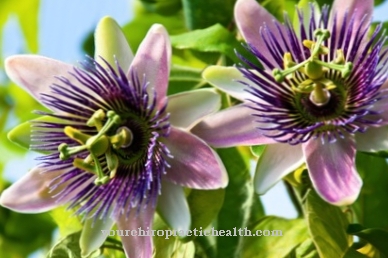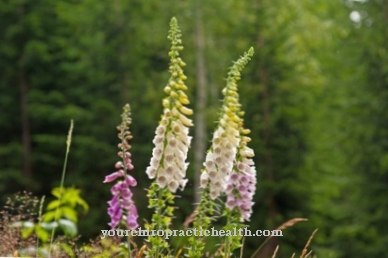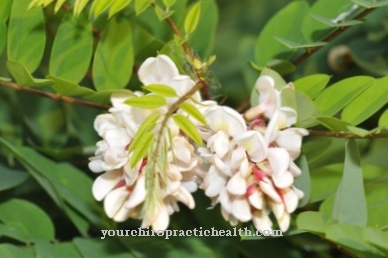Buckwheat is a valuable food, but despite the irritating name, it does not belong to the category of grain. Because it is gluten and lectin free, it is a healthy grain alternative. What effects is it said to have and what risks should be taken into account when consuming it?
Occurrence and cultivation of buckwheat

Buckwheat belongs to the plant genus of the knotweed family and its name refers to the beech-corner-shaped fruits. Buckwheat is native to Mongolia and has spread across large parts of Europe. Even if the name suggests that it is a grain, this claim is wrong.
The herbaceous plant is usually annual and is between 15 and 70 centimeters high.The stem of buckwheat is bald to finely haired and forms a taproot in the earth. Its color changes from green to a strong red. The leaves are stalked and alternate and have a pointed or flattened tip.
The flowers of buckwheat are white-pink and can be admired between June and October in fields, roadsides and lime-poor soils. In late autumn, the three-edged nut fruits develop from the flowers. The seeds, which are brown-gray, are similar to the beechnuts and are collected from September to November. The herb, on the other hand, is harvested between June and August.
Buckwheat seeds can be sown from late April to May. The plant is very rarely found in the wild, which is why it is mostly grown at home. It needs a sunny location and does not tolerate frost. At the beginning of the flowering period, the buckwheat seeds are harvested and, after air-drying, stored in a dark place.
Effect & application
Since the fruits of buckwheat are gluten-free, the plant plays an important role in the nutrition of people who suffer from celiac disease (gluten intolerance). Buckwheat is used in herbal medicine, folk medicine and also in homeopathy. Buckwheat contains high quality nutrients and vital substances and contains less protein. It supplies all eight essential amino acids and covers the protein requirement better than any grain. It is proven to have an antihypertensive effect. The rutin contained in buckwheat, also known as vitamin P, works wonders. It has been proven that it can reduce oxidative damage to the blood vessel walls and the result is a decrease in high blood pressure.
Buckwheat is a particularly valuable food for diabetics. It contains the substance chiro-inositol, which can regulate the blood sugar level. A regular diet of buckwheat can reduce the risk of complications from diabetes, such as heart problems.
People who suffer from weak veins will find a plant in the superfood buckwheat that provides relief. Rutin strengthens the blood vessel walls and the capillary walls. The elasticity and elasticity of the veins are increased. This counteracts the formation of varicose veins and hemorrhoids. The antioxidant property also has a positive effect on the vascular system. This means that vascular damaging oxygen compounds can be captured and neutralized.
In addition to protein, fats and vitamins, buckwheat also contains fiber and large amounts of lecithin. These two ingredients help regulate cholesterol levels. The lecithin inhibits the mechanism by which cholesterol is absorbed through the intestinal mucosa. The cholesterol is excreted again and the rise in the cholesterol level is not favored.
Buckwheat is also valuable for the liver. Lecithin helps the liver cells in their work and so no mistake can be made in the main task of detoxifying the body.
Importance for health, treatment & prevention
Buckwheat is consumed in the form of tea. A tablespoon of the buckwheat herb is poured over with 250 milliliters of boiling water. The tea should steep for 15 minutes and then strained. Up to three cups of tea can be drunk daily. During a four to eight week cure, the veins and capillary vessels are strengthened and blood circulation is promoted.
The first effect starts about two weeks after the start of the treatment. In addition to drinking buckwheat tea, capsules or tablets containing powdered buckwheat can also be taken. This cure also has a positive effect on our brain and performance increases. People who eat buckwheat are also less likely to develop depression and suffer from anxiety.
A porridge made from buckwheat strengthens the body and helps with suffering from slimy diarrhea. For blemished skin, the paste is applied to the affected areas. The ingestion of buckwheat has taken a high priority in naturopathy. However, it should be noted that allergies can also occur. This can lead to allergic skin reactions when touching the fresh parts of the plant.
If dry parts of the plant are used, inhalation of the dust can lead to asthma attacks and promote inflammation of the nasal mucous membrane. In rare cases, regular use can cause headaches. This depends on the harvest time of the buckwheat, as the plant can contain traces of FAGO-Pyrin. This substance also makes the skin more sensitive to light.
Buckwheat can be bought as a food in the form of seeds, flour or porridge in organic shops, health food stores and selected supermarkets. Pharmacies and drugstores sell tablets and capsules. The exact application and dosage is given in the package insert. In the event of special problems, a pharmacist should provide information or a doctor should be consulted.













.jpg)

.jpg)
.jpg)











.jpg)